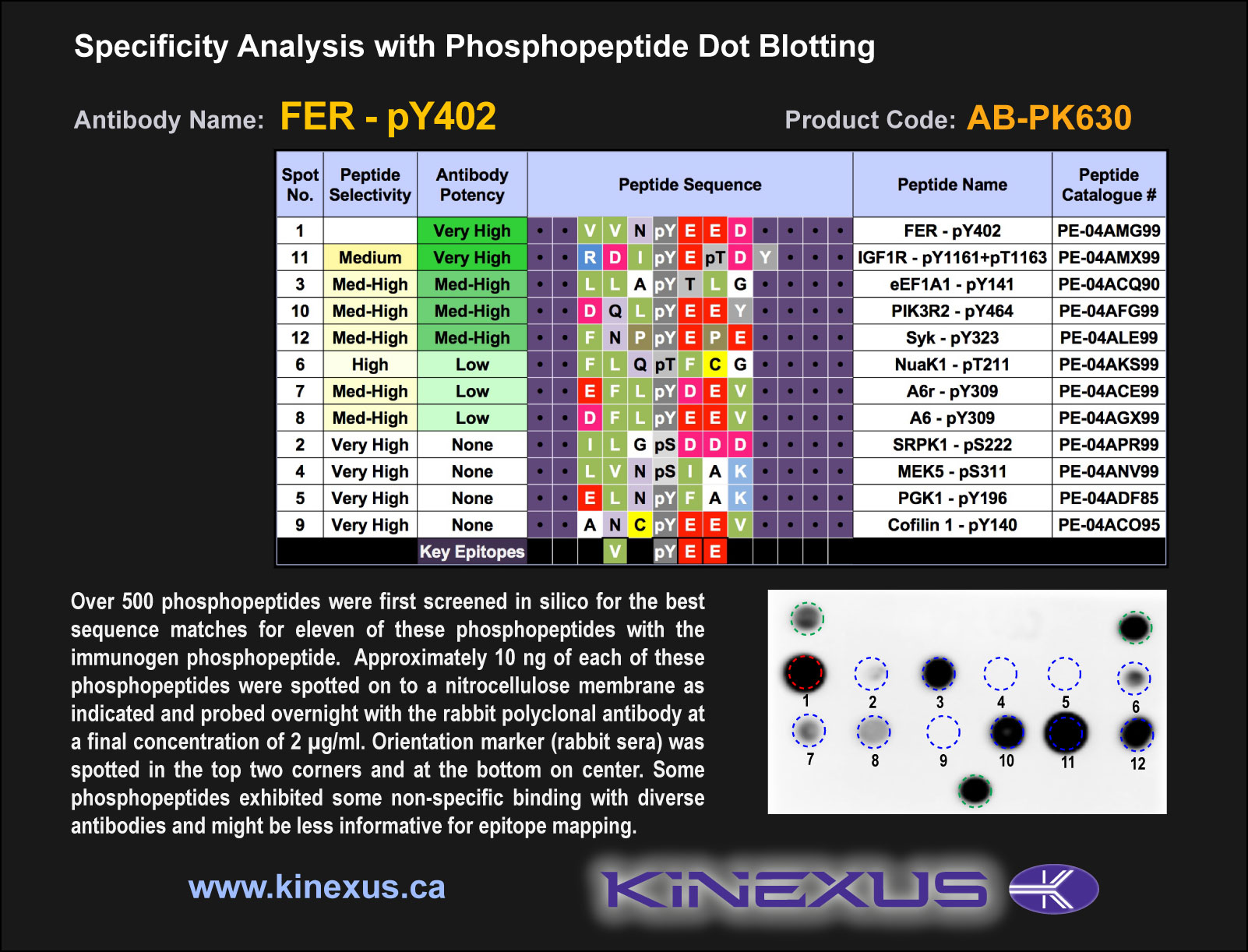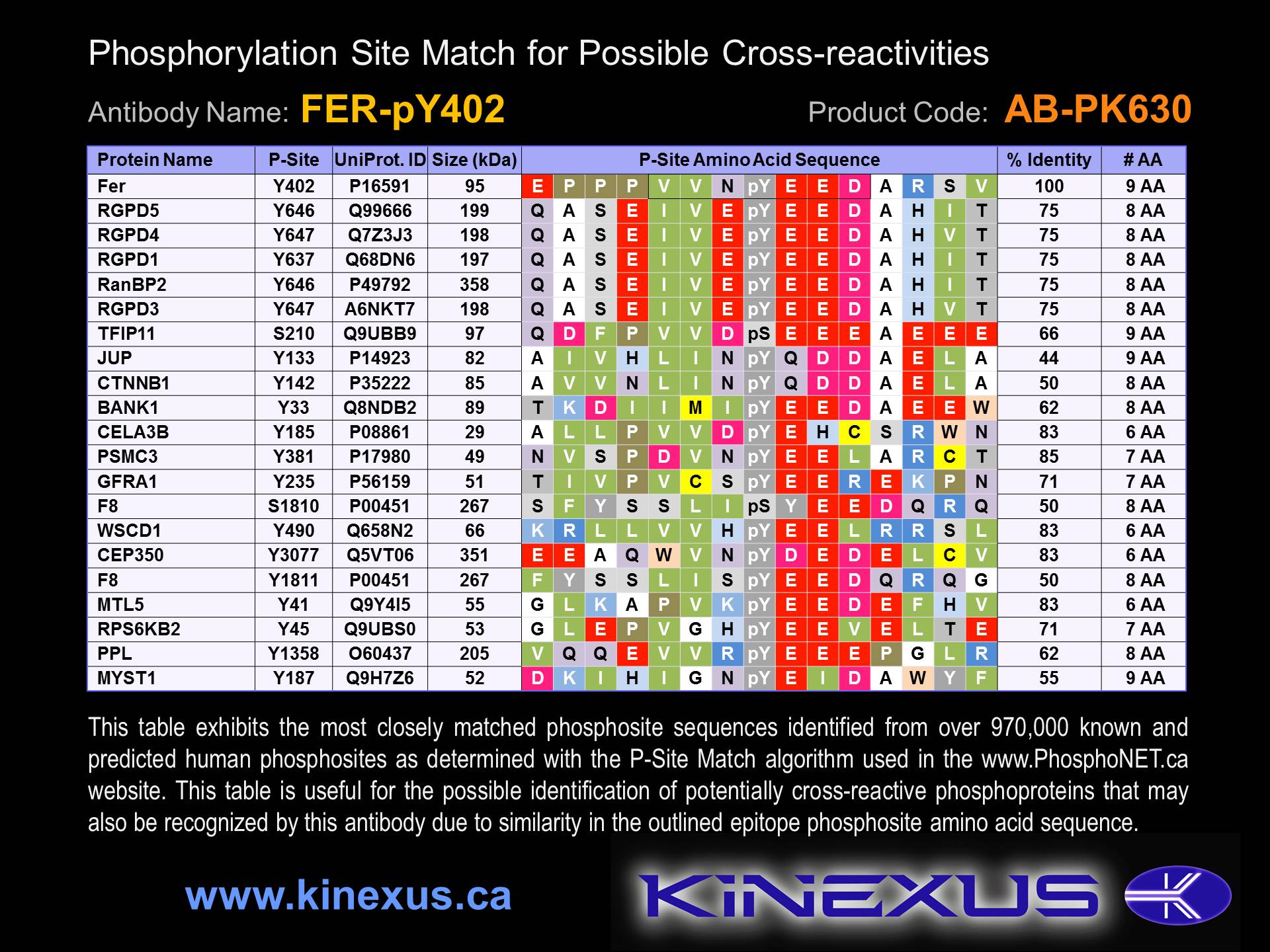Product Name: Fer-pY402
Product Number: AB-PK630
| Size: | 25 µg | Price: | 89.00 | |
| $US |
Target Full Name: Fer (fps/fes related) protein-tyrosine kinase
Target Alias: AV082135; C-Fer; Fer; Fer (fps/fes related) tyrosine kinase; FerT2; Kinase Fer; P94-Fer; Phosphoprotein NCP94; TYK3; PPP1R74; CCDS4098.1; ENSG00000151422; B4DDX7
Product Type Specific: Protein kinase phosphosite-specific antibody
Antibody Code: PK630
Antibody Target Type: Phosphosite-specific
Antibody Phosphosite: Y402
Protein UniProt: P16591
Protein SigNET: P16591
Antibody Type: Polyclonal
Antibody Host Species: Rabbit
Target Alias: AV082135; C-Fer; Fer; Fer (fps/fes related) tyrosine kinase; FerT2; Kinase Fer; P94-Fer; Phosphoprotein NCP94; TYK3; PPP1R74; CCDS4098.1; ENSG00000151422; B4DDX7
Product Type Specific: Protein kinase phosphosite-specific antibody
Antibody Code: PK630
Antibody Target Type: Phosphosite-specific
Antibody Phosphosite: Y402
Protein UniProt: P16591
Protein SigNET: P16591
Antibody Type: Polyclonal
Antibody Host Species: Rabbit
Antibody Immunogen Source: Human Fer (TYK3) sequence peptide Cat. No.: PE-04AMG99
Antibody Immunogen Sequence: VVN(pY)EED(bA)C
Antibody Immunogen Description: Corresponds to amino acid residues V399 to D405; In the region preceding the SH2 domain. One of the two major in vivo phosphorylations sites in Fer.
Antibody Immunogen Sequence: VVN(pY)EED(bA)C
Antibody Immunogen Description: Corresponds to amino acid residues V399 to D405; In the region preceding the SH2 domain. One of the two major in vivo phosphorylations sites in Fer.
Production Method: The immunizing peptide was produced by solid phase synthesis on a multipep peptide synthesizer and purified by reverse-phase hplc chromatography. Purity was assessed by analytical hplc and the amino acid sequence confirmed by mass spectrometry analysis. This peptide was coupled to KLH prior to immunization into rabbits. New Zealand White rabbits were subcutaneously injected with KLH-coupled immunizing peptide every 4 weeks for 4 months. The sera from these animals was applied onto an agarose column to which the immunogen peptide was thio-linked. Antibody was eluted from the column with 0.1 M glycine, pH 2.5. Subsequently, the antibody solution was neutralized to pH 7.0 with saturated Tris.This antibody was also subject to negative purification over phosphotyrosine-agarose.
Antibody Modification: Unconjugated. Contact KInexus if you are interest in having the antibody biotinylated or coupled with fluorescent dyes.
Antibody Modification: Unconjugated. Contact KInexus if you are interest in having the antibody biotinylated or coupled with fluorescent dyes.
Antibody Concentration: 1 mg/ml
Storage Buffer: Phosphate buffered saline pH 7.4, 0.05% Thimerasol
Storage Conditions: For long term storage, keep frozen at -40°C or lower. Stock solution can be kept at +4°C for more than 3 months. Avoid repeated freeze-thaw cycles.
Product Use: Western blotting | Antibody microarray
Antibody Dilution Recommended: 2 µg/ml for immunoblotting
Antibody Potency: Very strong immunoreactivity with immunogen peptide on dot blots.
Antibody Species Reactivity: Human
Antibody Positive Control: The observed molecular mass of the processed target protein on SDS-PAGE gels is reported to be around 90-100 kDa.
Storage Buffer: Phosphate buffered saline pH 7.4, 0.05% Thimerasol
Storage Conditions: For long term storage, keep frozen at -40°C or lower. Stock solution can be kept at +4°C for more than 3 months. Avoid repeated freeze-thaw cycles.
Product Use: Western blotting | Antibody microarray
Antibody Dilution Recommended: 2 µg/ml for immunoblotting
Antibody Potency: Very strong immunoreactivity with immunogen peptide on dot blots.
Antibody Species Reactivity: Human
Antibody Positive Control: The observed molecular mass of the processed target protein on SDS-PAGE gels is reported to be around 90-100 kDa.
Antibody Specificity: High-very high
Antibody Cross Reactivity: No significant cross-reactive proteins detected in sea star oocytes.
Related Product 1: Fer-pY402 blocking peptide
Related Product 2: FesSubtide - Fes protein kinase substrate peptide
Antibody Cross Reactivity: No significant cross-reactive proteins detected in sea star oocytes.
Related Product 1: Fer-pY402 blocking peptide
Related Product 2: FesSubtide - Fes protein kinase substrate peptide
Scientific Background: Fer is a protein-tyrosine kinase of the TK group and Fer family. Fer is a downstream mediator of growth factor signalling through EGF and PDGF receptor tyrosine kinases. It regulates cell adhesion and mediates signalling downstream of growth factor receptors. It has a role in regulating actin cytoskeleton and microtubule assembly required for cellular migration and attachment. It has a wide range of functions including potential regulation of the mitotic cell cycle, regulation of mast cell degranulation, leukocyte recruitment, and neuronal cell death after brain damage. Changes in leukocyte migration in Fer mutant mice indicate Fer may have a role in innate immunity regulation. This kinase is moderate to highly expressed in most tested human tissues. Fer has been found to activate NF-kB and promote cell proliferation. Overexpression of Fer has been implicated in increasing the tumorigenicity of prostate cancer cell lines as well as increasing resistance to chemotherapeutics such as quinacrine which inhibits NF-kB activation. Fer is highly related in structure to Fes/Fps, which is an oncoprotein that was originally identified in chicken and cat retroviral-induced cancers. Fer is required for cell-cycle progression in malignant cells. Decreasing the level of Fer using RNAi impeded the proliferation of prostate and breast carcinoma cells and led to their arrest at the G0/G1 phase. Fer has also been linked with the development of lung small cell carcinomas (LSCC).
Figure 1. Epitope mapping of FER-pY402 antibody with similar phosphopeptides on dot blots.
Figure 2. Identification of phosphosites related to FER-pY402.
© Kinexus Bioinformatics Corporation 2017



